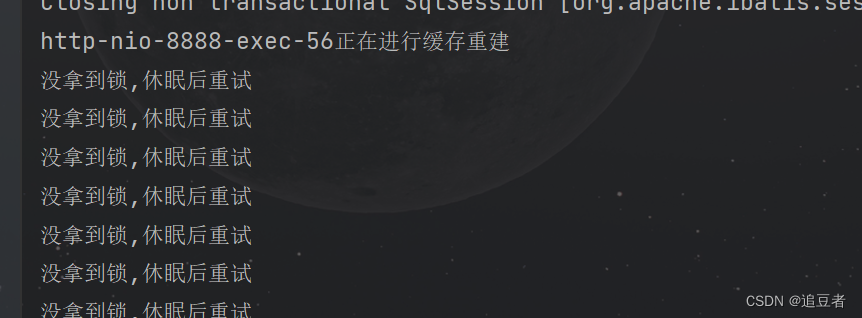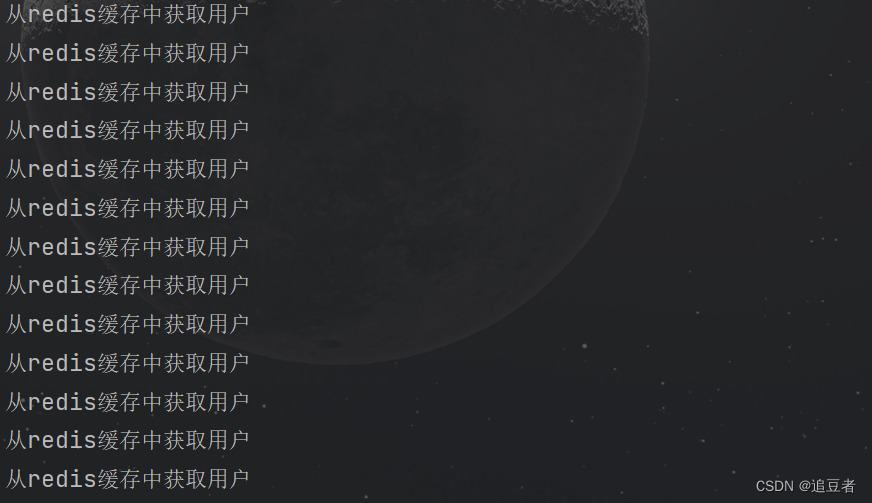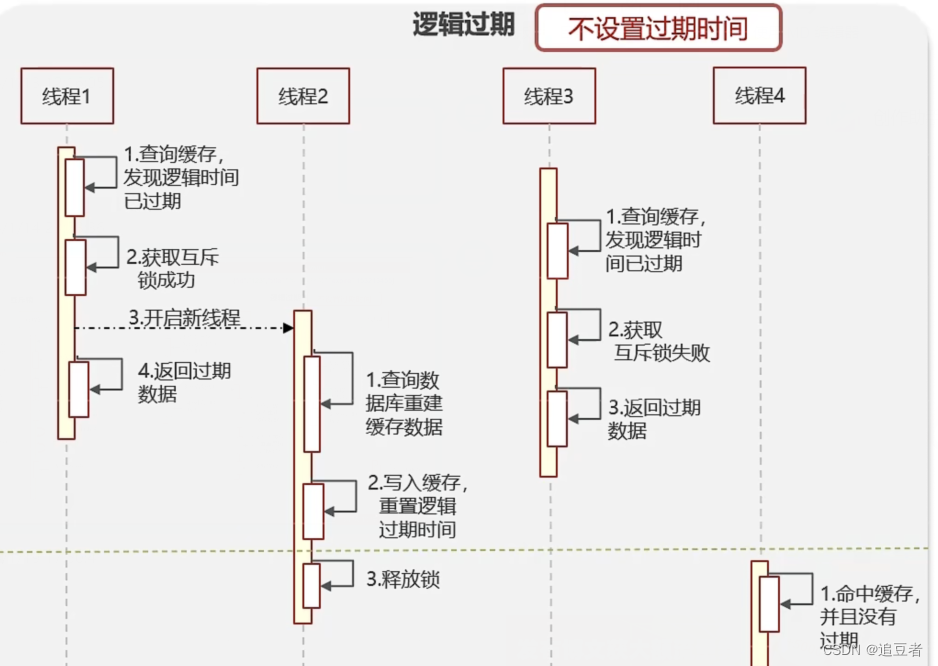模拟缓存击穿并提供解决方案
在聊到这个问题的时候我们首先要知道什么是缓存击穿,缓存击穿也叫做热点key问题,一个热点key在高并发的场景下突然失效了,此时很多的请求会在瞬间给数据库带来巨大冲击。数据库的压力就会很大,有挂掉的可能性。
现在我们来模拟一下缓存击穿的场景,现在缓存中有缓存用户1,将在51s后过期
我们用key的过期来模拟热点key失效的问题。
我们在 22s的时候用jmerter进行压测,模拟高并发场景下的情况。

测试代码如下:
package com.qjc.interview.Cache.penetration.controller;
import com.google.common.hash.BloomFilter;
import com.google.common.hash.Funnels;
import com.qjc.interview.Cache.penetration.pojo.User;
import com.qjc.interview.Cache.penetration.service.UserService;
import net.minidev.json.JSONValue;
import org.springframework.beans.factory.annotation.Autowired;
import org.springframework.data.redis.core.RedisTemplate;
import org.springframework.web.bind.annotation.GetMapping;
import org.springframework.web.bind.annotation.PathVariable;
import org.springframework.web.bind.annotation.RequestMapping;
import org.springframework.web.bind.annotation.RestController;
import java.util.concurrent.TimeUnit;
/**
* @Auther: QuJingChuan
* @Date: 2024/1/14 08:33
* @Description:
*/
@RestController
@RequestMapping("/test")
public class PenetrationController {
@Autowired
private UserService userService;
@Autowired
private RedisTemplate<String,String> redisTemplate;
@GetMapping("/queryById/{id}")
public User queryUserById(@PathVariable("id") Integer id){
/* //这个布隆过滤器用来存储integer类型的数据,初始化大小为1000.误判率在百分之5
BloomFilter<Integer> bloomFilter = BloomFilter.create(Funnels.integerFunnel(),1000,0.05);
//将表中的主键初始化进入布隆过滤器(因为我这里只有一条数据,我就直接加入进去了)
bloomFilter.put(1);
//判断布隆过滤器中是否有数据,没有直接返回.
if (!bloomFilter.mightContain(id)){
System.out.println("布隆过滤器中无数据,直接返回");
return null;
}*/
//先从redis查询有无缓存对象
String userStr = redisTemplate.opsForValue().get("缓存用户" + id);
if (userStr != null){
//redis缓存中有数据
System.out.println("从redis缓存中获取用户");
return JSONValue.parse(userStr,User.class);
}
User user = userService.SelectUserById(id);
System.out.println("从数据库中获取用户");
if (user ==null){
return null;
}
/* //缓存重建
redisTemplate.opsForValue().set("缓存用户"+id, JSONValue.toJSONString(user),60, TimeUnit.SECONDS);*/
return user;
}
}测试结果如下:


很明显可以看到,当缓存没有过期的时候高并发的场景下是从redis缓存中获取数据的,但是当redis中的key过期后,剩下的大量请求打入了数据库,造成数据库压力过大。
常见的解决方案如下所示
1.设置互斥锁(分布式锁)
Redis中的setnx方法
在Redis中,SETNX是一个用于设置指定键的值的命令。它会在键不存在时设置键的值,并且如果键已经存在,则不会进行任何操作。这个命令通常用于在设置某个键的值时,确保该键不存在,以避免覆盖已有的值。
简单的说就是当高并发场景下当有一个线程发现了redis缓存中取不到数据后,这个线程会进行缓存重建(获取该对象的锁),在缓存重建的过程中仅仅有一个线程进行缓存重建,其他的线程将尝试进行缓存重建(但是由于没有拿到这个对象的锁),因为该对象锁被其中一个线程占用,因此其他的线程将会不断地休眠 ,并且重新查询缓存,若缓存没有重建完成继续尝试并且获取锁。
具体图示如下

具体的代码实现如下
package com.qjc.interview.Cache.penetration.controller;
import com.google.common.hash.BloomFilter;
import com.google.common.hash.Funnels;
import com.qjc.interview.Cache.penetration.pojo.User;
import com.qjc.interview.Cache.penetration.service.UserService;
import jakarta.annotation.Resource;
import net.minidev.json.JSONValue;
import org.redisson.api.RLock;
import org.redisson.api.RedissonClient;
import org.springframework.beans.factory.annotation.Autowired;
import org.springframework.data.redis.core.RedisTemplate;
import org.springframework.data.redis.core.convert.RedisData;
import org.springframework.web.bind.annotation.GetMapping;
import org.springframework.web.bind.annotation.PathVariable;
import org.springframework.web.bind.annotation.RequestMapping;
import org.springframework.web.bind.annotation.RestController;
import java.util.concurrent.TimeUnit;
/**
* @Auther: QuJingChuan
* @Date: 2024/1/14 08:33
* @Description:
*/
@RestController
@RequestMapping("/test")
public class PenetrationController {
@Autowired
private UserService userService;
@Autowired
private RedisTemplate<String,String> redisTemplate;
@Autowired
private RedissonClient redissonClient;
@GetMapping("/queryById/{id}")
public User queryUserById(@PathVariable("id") Integer id){
/* //这个布隆过滤器用来存储integer类型的数据,初始化大小为1000.误判率在百分之5
BloomFilter<Integer> bloomFilter = BloomFilter.create(Funnels.integerFunnel(),1000,0.05);
//将表中的主键初始化进入布隆过滤器(因为我这里只有一条数据,我就直接加入进去了)
bloomFilter.put(1);
//判断布隆过滤器中是否有数据,没有直接返回.
if (!bloomFilter.mightContain(id)){
System.out.println("布隆过滤器中无数据,直接返回");
return null;
}*/
//先从redis查询有无缓存对象
String userStr = redisTemplate.opsForValue().get("缓存用户" + id);
if (userStr != null){
//redis缓存中有数据
System.out.println("从redis缓存中获取用户");
return JSONValue.parse(userStr,User.class);
}
//TODO 分布式锁解决缓存击穿
//获取互斥锁
String lockKey = "lock" + id;
try {
boolean isLock = tryLock(lockKey);
//获取锁是否成功
if (!isLock){
//失败,休眠重试
System.out.println("没拿到锁,休眠后重试");
Thread.sleep(50);
//递归
return queryUserById(id);
}
//有一个线程拿到id并且查询数据库
System.out.println(Thread.currentThread().getName() + "拿到锁");
User user = userService.SelectUserById(id);
//数据库中没有
if (user == null){
//将空值写入redis
redisTemplate.opsForValue().set("缓存用户" + id,null,10,TimeUnit.SECONDS);
return null;
}
//重建缓存
redisTemplate.opsForValue().set("缓存用户" + id,JSONValue.toJSONString(user),30,TimeUnit.SECONDS);
}catch (Exception e){
throw new RuntimeException();
}
//释放锁
unlock(lockKey);
return JSONValue.parse(redisTemplate.opsForValue().get("缓存用户"+id),User.class);
}
//尝试获取锁的方法
private boolean tryLock(String key){
//setnx
boolean flag = redisTemplate.opsForValue().setIfAbsent(key, "1", 10, TimeUnit.SECONDS);
return flag;
}
//释放锁的代码
private void unlock(String key){
redisTemplate.delete(key);
}
}压力测试如下
我的缓存中现在没有数据,那就直接让线程新建数据目标key是 “缓存用户1”?
执行代码后结果如下
缓存中
等缓存的数据块过期时,我们此时发送大量的高并发数据进行测试
测试结果如下



可以清楚的看到,我们在1s中发了2000次请求的时候,仅仅有一个线程拿到了锁(http-nio-8888-exec-56线程),并且这个线程对缓存进行了重建。后续的所有线程都在redis缓存中取到了数据。
2.设置逻辑过期时间
在这里给各位小伙伴们解释一下什么事设置逻辑过期时间,我们在第一次将数据加入缓存中不给他设置过期时间,但是我们给他传入的时候设置一个逻辑过期时间。当我们每次取出这个缓存的时,我们用当前的时间和逻辑过期的时间来对比,看看这个缓存是否"过期"(实际是不会过期的)。
具体流程图如下:

这里和上述的分布式锁解决缓存击穿问题有明显的区别,很显然当一个线程发现时间过期后并且没有获取到锁进行缓存重建,但是这里却没有重试等待而是选择了将之前的值进行返回。
代码如下
这里要单独封装一份redisData数据,因为redis中默认没有给逻辑过期,因此我们需要自行封装逻辑过期时间。
?
package com.qjc.interview.Cache.penetration.pojo;
import lombok.AllArgsConstructor;
import lombok.Data;
import lombok.NoArgsConstructor;
import java.time.LocalDateTime;
/**
* @Auther: QuJingChuan
* @Date: 2024/1/21 11:03
* @Description:
*/
@Data
@AllArgsConstructor
@NoArgsConstructor
public class RedisData {
//封装逻辑过期
private LocalDateTime expireTime; //逻辑过期时间
private String data; //用于存放数据
}package com.qjc.interview.Cache.penetration.controller;
import com.google.common.hash.BloomFilter;
import com.google.common.hash.Funnels;
import com.qjc.interview.Cache.penetration.pojo.RedisData;
import com.qjc.interview.Cache.penetration.pojo.User;
import com.qjc.interview.Cache.penetration.service.UserService;
import jakarta.annotation.Resource;
import net.minidev.json.JSONValue;
import org.redisson.api.RLock;
import org.redisson.api.RedissonClient;
import org.springframework.beans.factory.annotation.Autowired;
import org.springframework.data.redis.core.RedisTemplate;
import org.springframework.web.bind.annotation.GetMapping;
import org.springframework.web.bind.annotation.PathVariable;
import org.springframework.web.bind.annotation.RequestMapping;
import org.springframework.web.bind.annotation.RestController;
import java.time.Instant;
import java.time.LocalDateTime;
import java.time.ZoneId;
import java.util.concurrent.ExecutorService;
import java.util.concurrent.Executors;
import java.util.concurrent.TimeUnit;
/**
* @Auther: QuJingChuan
* @Date: 2024/1/14 08:33
* @Description:
*/
@RestController
@RequestMapping("/test")
public class PenetrationController {
@Autowired
private UserService userService;
@Autowired
private RedisTemplate<String, String> redisTemplate;
@GetMapping("/queryById/{id}")
public User queryUserById(@PathVariable("id") Integer id) {
//TODO 逻辑过期解决缓存击穿问题
//从缓存中获取对象
String cacheKey = "缓存用户" + id;
//创建一个固定大小的线程池,方便进行缓存重建
ExecutorService CACHE_REBUILD_EXECUTOR = Executors.newFixedThreadPool(1);
String userJson = redisTemplate.opsForValue().get(cacheKey);
if (userJson == null || "".equals(userJson)) {
System.out.println("用户不存在");
return null;
}
//命中缓存
RedisData redisData = JSONValue.parse(userJson, RedisData.class);
User user = JSONValue.parse(redisData.getData(),User.class);//转换为java对象
//获取过期时间
LocalDateTime expireTime = redisData.getExpireTime();
//判断逻辑是否过期
if (expireTime.isAfter(LocalDateTime.now())) {
// 未过期逻辑 直接返回数据
return user;
}
// 过期了,进行缓存重建 获取锁
boolean isLock = tryLock("lock" + id);
if (isLock) {
// 获取锁成功 新开启一个线程进行缓存重建
CACHE_REBUILD_EXECUTOR.submit(() -> {
try {
//缓存重建
this.saveRedis(id,20L);
} catch (Exception e) {
throw new RuntimeException();
} finally {
//释放锁
unlock("lock" + id);
}
});
}
//关闭线程池
CACHE_REBUILD_EXECUTOR.shutdown();
//返回商铺信息
return user;
}
//设置逻辑过期的方法 并进行缓存预热
public void saveRedis(Integer id, Long expireTime) {
//查询用户信息
User user = userService.SelectUserById(id);
//封装逻辑过期时间和用户数据
RedisData redisData = new RedisData();
redisData.setData(JSONValue.toJSONString(user));
redisData.setExpireTime(LocalDateTime.now().plusSeconds(expireTime));
//将数据写入缓存
redisTemplate.opsForValue().set("缓存用户" + id,JSONValue.toJSONString(redisData));
}
//尝试获取锁的方法
private boolean tryLock(String key) {
//setnx
boolean flag = redisTemplate.opsForValue().setIfAbsent(key, "1", 10, TimeUnit.SECONDS);
return flag;
}
//释放锁的代码
private void unlock(String key) {
redisTemplate.delete(key);
}
}总结
分布式锁和逻辑过期都是解决缓存击穿的常见解决方式,但是分布式锁保证了数据的高度一致性,但是由于不断地尝试获取锁,递归方法和休眠一段时间,会导致性能不及逻辑过期的性能好,逻辑过期保证了性能,但是没有保证数据的高度一致性(因为在缓存没有重建好及时逻辑过期了仍然返回之前的假数据)。大家根据具体业务进行甄别和使用即可。
本文来自互联网用户投稿,该文观点仅代表作者本人,不代表本站立场。本站仅提供信息存储空间服务,不拥有所有权,不承担相关法律责任。 如若内容造成侵权/违法违规/事实不符,请联系我的编程经验分享网邮箱:chenni525@qq.com进行投诉反馈,一经查实,立即删除!
- Python教程
- 深入理解 MySQL 中的 HAVING 关键字和聚合函数
- Qt之QChar编码(1)
- MyBatis入门基础篇
- 用Python脚本实现FFmpeg批量转换
- Weblogic Server工具WLST的使用
- MathType中文网站2024最新版本下载及嵌入word教程
- 如何进行实例管理
- Apache网页优化
- mmdetection3.2.0之RetinaNet源码解读
- 【开源】基于JAVA的班级考勤管理系统
- 代码随想录算法训练营第五十天|123.买卖股票的最佳时机III、188.买卖股票的最佳时机IV
- 【力扣】21.合并两个有序链表
- 软件测试|解决‘pip‘ 不是内部或外部命令,也不是可运行的程序或批处理文件
- IMU用于无人机故障诊断